Even though marine mammals are protected under the Marine Mammal Protection Act, there are still many things that threaten their survival. Most of the current threats of marine mammals are caused either directly or indirectly by humans.
Ship strikes
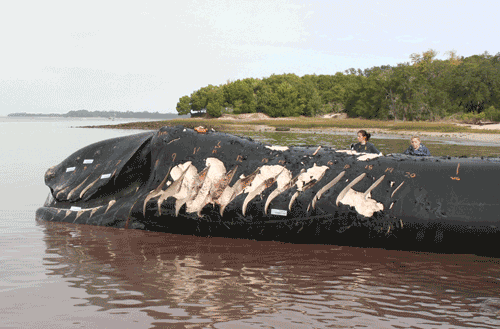
One of many human created problems for marine mammals are ship strikes (when a ship hits a marine mammal). Ship strikes have likely occurred since man started sailing the high seas. One of the earliest documented ship strikes occurred in 1885 off the coast of Massachusetts. As ships have become larger and faster, ship strikes occur more often, because it is harder for the animals to move out of the path of the ships. The International Whaling Commission have documented over 1,000 ship strikes. With the addition of undocumented ship strikes the number of ship strikes is likely much higher. On some circumstances ships were unaware of a strike until they entered port. Ship strikes typically injure or kill cetaceans by propeller strikes or blunt trauma.
Species like the North Atlantic right whale (Eubalaena glacialis) that have their breeding grounds in a high traffic area off the southeast coast of the United States are vulnerable to ship strikes. Because of the limited number of North Atlantic right whales worldwide, ship strikes pose a major threat to this species' long-term survival. To minimize ships striking right whales, the Right Whale Ship Strike Reduction Rule was passed to require large ships (> 65 ft length; 19.8 m) to slow their speed in right whale management areas along the east coast. Because large ships have limited maneuverability, slowing their speeds in areas where whales are likely to occur may give whales the opportunity to avoid collision.
Past and Present direct harvest
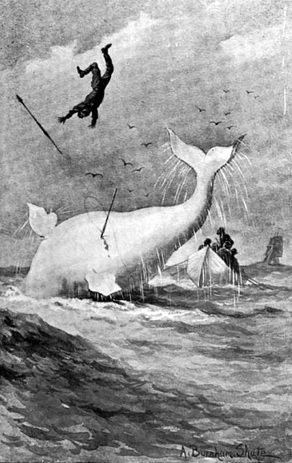
Image from Moby Dick
The method of early whalers, using wind power or men rowing oars to move their boats and hand-thrown harpoons, limited the numbers and species of whales that early whalers could hunt. During this early period of commercial whale harvest(from the 11th century to the middle 19th century), the slower whales, like humpback, right, and sperm whales, were targeted. In the mid-19th century, whale hunters started using mechanized harpoons, steam to power their boats, and compressed air to help keep their catch afloat. As hunting methods and equipment improved, the faster whales, including blue, sei, and Bryde’s whales all became more common targets. By 1900, many whale populations declined so much from hunting that it was no longer profitable to hunt them. In 1925, the first factory ships began processing whale products at sea, rather than bringing whale parts back to the coast for processing. This allowed the whaling industry to process the whales as fast as they were caught. As the whaling industry became more mobile and whale populations became depleted in areas close to ports, the industry started whaling farther from ports including in the Antarctic. From 1904-1983, over two million whales in the southern hemisphere were killed.
After the moratorium on all commercial whaling enacted by the International Whaling Commission in 1986, only aboriginal peoples could hunt whales legally. Some countries have continued whaling since the moratorium in 1986. The impact of illegal whaling on whale populations is unknown.
Fisheries bycatch
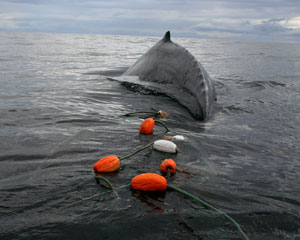
Humpback whale entangled in a gill net. Photo Credit: Aleria Jensen, NOAA/NMFS/AKFSC
Marine mammals are also vulnerable to being caught in commercial fishing equipment. Some scientists have estimated that hundreds of thousands of marine mammals have died as a result of being bycatch in the commercial fishing industry worldwide. Bycatch are animals that are caught accidently in the process of commercial fishing. Many animals captured as bycatch are killed during the process. Hundreds of thousands of marine mammals are estimated to die as fishery bycatch each year. For some populations, fisheries bycatch could be a major threat to their continued existence.
Marine mammals can also become entangled in gillnets, trawl nets, fishing line, and other fishing gear, which may lead to death or a more difficult life attempting to feed, swim, and avoid predators tangled with lines and other material. A single ship fishing for squid in the Pacific uses approximately 20 km of net in a single night. If all squid fishing ships use a similar amount of net, almost 9,000 miles (14,400 km) of net would be set each night during the squid fishing season in the Pacific. In an attempt to reduce by-catch of marine mammals, teams of representatives from federal, state, university, and fisheries organizations have developed methods and regulations to minimize marine mammal deaths. These regulations include restrictions on where fishermen can fish, modified gear, and modified fishing techniques. Since these restrictions and modifications have been enacted, deaths of marine mammals caused by commercial fishery by-catch has been on the decline.
Pollution
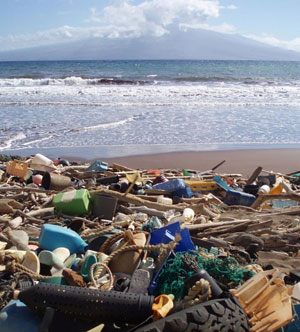
Photo credit: NOAA National Ocean Service
Because of the increasing use of plastics in today’s society, the quantity of plastic debris found in the ocean has also increased. Plastics and other artificial materials last a long time and can take years or decades to begin to break down. Marine mammals can get entangled in these materials, which could cause them to drown, prevent them from eating, or prevent them from avoiding predators. Plastic bags are commonly found in the stomachs of stranded whale species. In the ocean, plastic may appear similar to food items (squid) and may be purposefully eaten, because the animal thinks it is food. Plastic bags that get eaten can get wedged or stuck in the stomach and intestines causing illness or death.
Another threat is chemical pollution and changes in water quality. Changes in the quality of water can occur through a variety of mechanisms, including oil spills, discharges from ships, and surface runoff from terrestrial sources. Oil pollution can come from multiple sources, including oil spills, ship maintenance, natural sources, offshore drilling, air pollution, and even used engine oil from road runoff. Oil from massive spills can coat marine mammals, making it difficult to keep warm. Marine mammals can also eat the oil causing illness and disease.
Contaminants, like organochlorines, can cause reduced reproductive success and other health concerns in animals and humans. Reduced reproductive success because of contaminants has been documented in bottlenose dolphins. Documenting contaminants in other less-common species and connecting it to declines in reproductive success may be much more difficult because studying them is more difficult. Some stranded striped dolphins that died of disease have had high levels of PCBs (polychlorinated biphenyls), an organochlorine. These contaminants can reduce the immune system of an animal and make them more vulnerable to disease and parasites.
Although excess nutrients from terrestrial or ship sources may not directly harm many marine mammals, it can alter the marine ecosystem on which they depend. Nutrient excess in the ocean can cause red tides. A large number of deaths of humpback whales in 1987-1988 was connected to the consumption of fish with large amounts of a toxin that is found in red tides. Deaths of some common bottlenose dolphins have also been linked to toxins found in red tides.
| How can sounds alter the behavior of a whale underwater? |
| While diving in water, as you go deeper the pressure (or "weight") of the water increases. This causes the air inside a whale's, and every animal's, body to compress. A whale's body can naturally adjust to these pressure changes as they dive and when they come back to the surface. Typically, all divers must rise to the surface at a slower rate than they dive to allow their body time to adjust to the changes in pressure. While being underwater an animal's tissues absorb more nitrogen than is normal. A whale naturally releases this built up nitrogen when they move to the surface at a normal rate. If they surface too quickly, the built up nitrogen expands, as a result of decreased pressure, and can form bubbles in their tissues and blood. These bubbles can cause life-threatening injuries in humans and most animals. This problem is called decompression sickness, also referred to in humans as "the bends". This problem is at least painful in humans, but can also cause death. |
| Beaked whales (Family Ziphiidae) have been known to dive deeply, 3,300-6,600 ft (1,000 to 2,000 m) for long periods of time, sometimes for over 60 minutes. These deep dives apparently make beaked whales more susceptible to harm caused by altered behavior while diving. Specifically, non-natural or anthropogenic sounds underwater (like sonar) may disrupt the dive and cause them to surface faster than normal, stay in a dive longer than normal, stay at the surface longer than normal, or dive earlier than normal. Any of these things could cause harm to a whale. Beaked whales may be susceptible to a type of decompression illness caused by disruptions when they are surfacing from dives and reduced time spent at the surface while allowing them to release excess nitrogen in their system. |
Noise Pollution
Many marine mammals use sound to capture their prey, avoid predators, and for communication. Unnatural sounds can have an affect on the behavior of some marine mammals. Because sound travels so well underwater, it is a topic of concern for many marine species. Some research suggests that mid and high-frequency sounds that are human-made (sonar and airguns) have caused strandings of some beaked whales. Another question is whether noise created by vessels may interfere with a marine mammal’s echolocation or communication. One study has linked ship noise to increased levels of stress in right whales.
New offshore wind farms may also be a source of non-natural noise. The effect of noise emitted from offshore wind farms has not been measured. However, if their frequencies are similar to those used by cetaceans for communication or high-frequencies that might alter marine mammal behavior in other ways. Ocean wind farms could be another concern for marine mammals in those areas.
Overexploitation of Prey
Another way the fishing industry has altered the marine environment is through diminishing populations of fish in certain areas. Marine mammals feeding on fish in these areas may need to alter what they feed on and how they do it. Reduced numbers of at least one killer whale, Orcinus orca, population appears to be closely related to a decline in their main food source because of industrial fishing practices.
Climate Change
Climate change is another threat to the future of marine mammals. As global temperature increases, there will be corresponding changes in ranges and abundance of fish, plankton, and other animal populations in the ocean. Along with these changes in food items for marine mammals, temperatures changes could change timing and routes of migration, and timing and success of having young. Some species that occur only in cold temperature waters or those only seen in tropical waters are likely to be affected the most by changing temperatures. Species or populations that have very specific life history requirements are also likely to be more affected by climate change.
Habitat Loss
Many species of whales move over large areas of ocean and habitat loss may not be as much of an issue as some other threats. However, some marine mammals are dependent on limited areas near the coasts that are heavily impacted by human use. These areas are subject to habitat degradation from pollution, sedimentation, and reduced water quality. In addition to habitat loss, the species that occur in coastal areas have to contend with increased boat traffic. Both pleasure craft and commercial craft close to shore contributes to stress and injury to marine mammals in coastal areas.
Natural
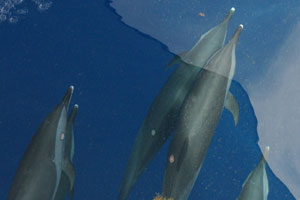
Cookie cutter shark injuries on a dolphin. Photo Credit: Wayne Hoggard NOAA/NMFS/SEFSC
Marine mammals are prey of sharks and killer whales. Smaller marine mammals can also be eaten by pygmy killer whales (Feresa attenuata), false killer whales (Pseudorca crassidens), and short-finned pilot whales (Globicephala macrorhynchus). Injuries caused cookie cutter sharks, Isistius sp., can cause problems for marine mammals. Cookie cutter sharks feed on marine mammals (and in one case a human) by grabbing a round chunk of skin, blubber, and muscle from its victim. This injury leaves a round scar on the animal after it is healed. Some marine mammals can have many injuries caused by cookie cutter sharks. Stingrays have been documented as a cause of death for some common bottlenose dolphins (Tursiops truncatus). These dolphins either have external wounds from the barbs of the rays or they eat small rays and the barb damages their internal organs causing death.
Another natural cause of death in marine mammals for species known to frequent areas of ice can get entrapped by ice. Ice entrapment can kill or injure a whale, dolphin, or porpoise by suffocation or crushing them between large pieces of floating ice. Areas close to the coast that have sources of freshwater, can freeze quickly and entrap marine mammals. A heavy layer of ice can keep the mammal from reaching the surface and getting air. Marine mammals living close to the coast, like harbor porpoises, Phocoea phocoena, occasionally become entrapped by ice formation at the mouths of rivers. Marine mammals can also die old age and natural diseases.
References:
Ainley, D.G., G. Ballard, and S. Olmastroni. 2009. An apparent decrease in the prevalence of "Ross Sea killer whales" in the southern Ross Sea. Aquatic Mammals 35(3): 335-347.
Baird R.W., D.L. Webster, D.J. McSweeney, A.D. Ligon, G.S. Schorr , and J. Barlow. 2006. Diving behaviour of Cuvier's (Ziphius cavirostris) and Blainville's (Mesoplodon densirostris) beaked whales in Hawai'i. Canadian Journal of Zoology 84: 1120-1128.
Baker, C.S. and S.R. Palumbi. 1994. Which whales are hunted? A molecular genetic approach to monitoring whaling. Science 265: 1538–1539.
Cassoff, RM, K.M. Moore, W.A. McLellan, S.G. Barco, D.S. Rotstein, and M.J. Moore. 2011. Lethal entanglement in baleen whales. Diseases of Aquatic Organisms 96: 175-185.
Clapham , P.J. and Baker, C.S. 2002. Modern whaling. In: Perrin, W.F., Würsig, B. & Thewissen, J. Encyclopedia of Marine Mammals, pp. 1328-1332. Academic Press, New York.
Clapham, P.J., S.B. Young, and R.L. Brownell, Jr. 1999. Baleen whales: conservation issues and the status of the most endangered populations. Mammal Review 29: 35-60.
Cox ,T.M., T.J. Ragen, A.J. Read, E. Vos, R.W. Baird, K. Balcomb, J. Barlow, J. Caldwell, T. Cranford, L. Crum, A. D’Amico, G. D’Spain, A. Fernández, J. Finneran, R. Gentry, W. Gerth, F. Gulland, J. Hildebrand, D. Houser, T. Hullar, P.D. Jepson, D. Ketten, C.D. MacLeod, P. Miller, S. Moore, D. Mountain, D. Palka, P. Ponganis, S. Rommel, T. Rowles, B. Taylor, P. Tyack, D. Wartzok, R. Gisiner, J. Mead, L. Benner. 2006. Understanding the impacts of anthropogenic sound on beaked whales. Journal of Cetacean Research and Management 7:177-187.
Endangered Fish and Wildlife; Final Rule To Implement Speed Restrictions to Reduce the Threat of Ship Collisions With North Atlantic Right Whales.” Federal Register 73: 198 (October 10, 2008) p. 60173. http://edocket.access.gpo.gov/2008/pdf/E8-24177.pdf.
Geraci, J.R., D.M. Anderson, R.J. Timperi, D.J. St. Aubin, G.A. Early, J.H. Prescott, and C.A. Mayo. 1989. Humpback whales (Megaptera novaeangliae) fatally poisoned by dinoflagellate toxins. Canadian Journal of Fisheries and Aquatic Science 46: 1895–1898.
Hildebrand, J.A. 2005. Impacts of anthropogenic sound. In Marine Mammal Research: Conservation Beyond Crisis. J.E. Reynolds III, W.F. Perrin, R.R. Reeves, S. Montgomery, and T.J. Ragen, eds, 101-124. John Hopkins University Press, Baltimore, Maryland.
Honebrink, R., R. Buch, P. Galpin, and G. Burgess. 2011. First documented attack on a live human by a cookiecutter shark (Squaliformes, Dalatiidae: Isistius sp.). Pacific Science 65: 365-374.
Hooker, S.K., R.W. Baird, and A. Fahlman. 2009. Could beaked whales get the bends? Effects of diving behaviour and physiology on modelled gas exchange for three species: Ziphius cavirostris, Mesoplodon densirostris and Hyperoodon ampullatus. Respiratory Physiology & Neurobiology 167:235-246.
Jacobsen, J.K., L. Massey, and F. Gulland. 2010. Fatal ingestion of floating net debris by two sperm whales (Physeter macrocephalus). Marine Pollution Bulletin 60: 765-767.
Laist, D.W. 1987. Overview of the biological effects of lost and discarded plastic debris in the marine environment. Marine Pollution Bulletin 18: 319-326.
Laist, D.W., A.R. Knowlton, J.G. Mead, A.S. Collet and M. Podesta. 2001. Collisions between ships and whales. Marine Mammal Science 17(1): 35-75.
Perrin W.F., B. Würsig, and J.G.M. Thewissen, eds. 2009. Encyclopedia of Marine Mammals. Academic Press, Amsterdam, p. 1316.
Potter, C.W. and B. Birchler. 1999. Pygmy sperm whale, Kogia breviceps. In The Smithsonian Book of North American Mammals. Wilson, D.E. and S. Ruff, eds., 301-302. Smithsonian Institution in association with the American Society of Mammologists, Washington DC.
Read, A.J., P. Drinker, and S. Northridge. 2006. Bycatch of marine mammals in U.S. and global fisheries. Conservation Biology 20: 163-169.
Rolland, R.M., S.E. Parks, K.E. Hunt, M. Castellote, P.J. Corkeron, D.P. Nowacek, S.K. Wasser, and S.D. Kraus. 2012. Evidence that ship noise increases stress in right whales. Proceedings of the Royal Society B published online 8 February 2012.
Simmonds, M.P. and W.J. Eliott. 2009. Climate change and cetaceans: concerns and recent developments. Journal of the Marine Biological Association of the United Kingdom 89: 203–210.
Uchida, R.N., 1985. The types and estimated amounts of fish net deployed in the North Pacific. Proceedings of the workshop on the fate and impact of marine debris, 27–29 November 1984, Honolulu, Hawaii. NOAA Tech.Memo. NMFS/SWFC-54. 37–108.
Wells, R.S., V. Tornero, A. Borrell, A. Aguilar, T.K. Rowles, H.L. Rhinehart, S. Hofmann, W.M. Jarman, A.A. Hohn, and J.C. Sweeney. 2005. Integrating life-history and reproductive success data to examine potential relationships with organochlorine compounds for bottlenose dolphins (Tursiops truncates) in Sarasota Bay, Florida. Science of The Total Environment 349: 106-119.
Weilgart, L.S. 2007. The impacts of anthropogenic ocean noise on cetaceans and implications for management. Canadian Journal of Zoology 85: 1091-1116.

 Marine Mammals of Georgia
Marine Mammals of Georgia